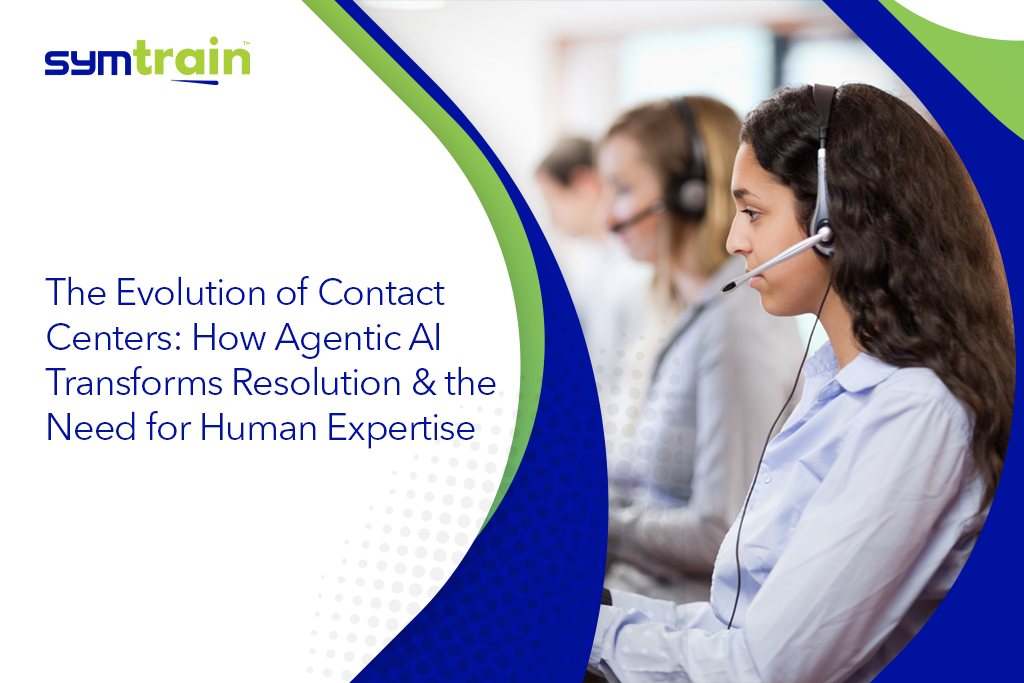The Evolution of Contact Centers: How Agentic AI Transforms Resolution and the Need for Human Expertise

1. Introduction: The Agentic AI Revolution in Customer Service
Agentic AI is the latest development in the application of AI for business enablement. AI Agents combine advanced Large Language Models with programmatic capabilities to create autonomous agents that can execute complex workflows. These differ from traditional AI chatbots as they can reason and execute actions autonomously to achieve a specific outcome. They reason, make decisions, and take actions independently to resolve the task presented to them.
While much discussion centers on job displacement, the real opportunity lies in workforce transformation. As Agentic AI rapidly automates mundane, repetitive Tier 1 tasks, human agents are not replaced but able to focus on complex, high-value interactions that require emotional intelligence and creative problem-solving. As human agents see this shift in workload, the need for high quality training rapidly increases as their volume of these Tier 2 and 3 tasks grow.
Definitions
Defining Resolution Tiers:
Tier 1: Simple, routine inquiries with straightforward solutions (password resets, account information, basic troubleshooting)
Tier 2: Moderate complexity issues requiring specialized knowledge or multi-step processes
Tier 3: Complex, sensitive, or escalated issues requiring expert judgment, regulatory compliance, or emotional support
Traditional AI vs. Agentic AI: Traditional chatbots follow decision trees and scripted (or prompted) responses, while Agentic AI can understand context, access multiple systems, execute workflows, and adapt responses based on real-time analysis of customer needs and system data.
2. Agentic AI's Natural Dominance in Tier 1 Resolution
Tier 1 issues are perfectly suited for Agentic AI automation because they involve simple actions and understanding with predictable outcomes. These interactions typically require accessing and following standard procedures, executing repetitive tasks and providing straightforward solutions.
Examples
Routine Inquiries: Account balance checks, service status updates, billing questions
Password Resets: Identity verification and secure credential management
Basic Troubleshooting: Step-by-step diagnostic procedures for common technical issues
Information Retrieval: Policy explanations, feature descriptions, and FAQ responses
3. The Human Advantage: Complexity and Empathy in Tier 2-3 Resolution
As AI handles routine tasks, human agents increasingly focus on complex scenarios that require sophisticated problem-solving, emotional intelligence, and relationship management skills.
Tier 2-3 Characteristics Requiring Human Intervention
Complex Problem-Solving: Multi-variable issues requiring creative solutions and system integration
Emotional Intelligence: De-escalation, empathy, and relationship building during frustrated or upset customer interactions
Regulatory Compliance: Sensitive situations involving privacy, legal requirements, or company policy interpretation
Enjoyable Customer Service: Creating positive experiences that build loyalty beyond simple problem resolution
4. AI-Powered Training and Education: Upleveling Human Performance
Rather than automating complex tasks, AI's role in Tier 2-3 support focuses on coaching and training enhancements. The importance of having adequately trained experts in this complex-task-resolution will drastically minimize handle time, improve performance metrics of human agents, and lead to better enablement for a success interaction of a human agent no matter the industry.
AI Coaching Capabilities:
Scenario-Based Training: Create realistic practice environments with AI-generated scenarios
Data-Driven Learning: Leveraging call recordings and QA metrics to identify specific improvement areas for individual agents
Targeted Skill Development: Minimizing time off calls while maximizing performance gains through personalized training modules
Rapid Market Transformation Response: As the contact center landscape evolves quickly, AI-powered training systems can rapidly update content, create new scenarios, and adapt learning paths to ensure agents stay current with emerging customer needs and service expectations.
Performance Optimization: By analyzing patterns in successful resolutions and customer satisfaction scores, AI can identify best practices and replicate them across the agent workforce through targeted training interventions, creating consistent excellence in complex customer interactions.
Industry Agnostic: Learning from historical data and previous interactions will enable AI to best approaches and learning material to improve best practices for how to handle interactions regardless of industry. This allows for dynamic application rather than a “one-size” approach give to human agents that likely need very different trainings.


